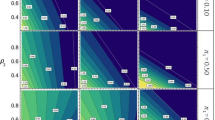Abstract
An iterative selection strategy, based on estimated breeding values (EBV) and average relationship among selected individuals, is proposed to optimise the balance between genetic response and inbreeding. Stochastic simulation was used to compare rates of inbreeding and genetic gain with those of other strategies. For a range of heritabilities, population sizes and mating ratios, the iterative strategy, denoted ADJEBV, outperforms other strategies, giving the greatest genetic gain at a given rate of inbreeding and the least breeding at a given genetic gain. Where selection is currently by truncation on the EBV, with a restriction on the number of full-sibs selected, it should be possible to maintain similar levels of genetic gain and inbreeding with a reduction in population size of 10–30%, by changing to the iterative strategy. If performance is measured by the reduction in cumulative inbreeding without losing more than a given amount of genetic gain relative to results obtained under truncation selection on the EBV, then with the EBV based on a family index, the performance of ADJEBV is greater at low heritability, and is generally greater than where EBV are based on individual records. When comparisons of genetic response and inbreeding are made for alternative breeding scheme designs, schemes which give higher genetic gain within acceptable inbreeding levels would usually be favoured. If comparisons are made on this basis, then the selection method used should be ADJEBV, which maximises the genetic gain for a given level of inbreeding. The results indicated that all selection strategies used to reduce inbreeding had very small effects on the variance of gain, and so differences in this respect are unlikely to affect choices among selection strategies. Selection criteria are recommended based on maximising a selection objective which specifies the desired balance between genetic gain and inbreeding.
Similar content being viewed by others
References
Brisbane JR, Gibson JP (1995a) Reduction of inbreeding through reduced correlations of estimated breeding values among relatives. Animal Science (submitted)
Brisbane JR, Gibson JP (1995b) Balancing selection response and inbreeding by including predicted asymptotic genetic contributions in selection decisions. Genet Select Evol (in press)
Brisbane JR, Gibson JP (1995c) Including genetic relationships in selection decisions: alternative methodologies. Theor Appl Genet (in press)
Bulmer MG (1971) The effect of selection on genetic variability. Am Nat 105:201–211
De Boer IJM, van Arendonk JAM (1994) Additive response to selection adjusted for effects of inbreeding in a closed dairy cattle nucleus assuming a large number of gametes per female. Anim Prod 58:173–180
Dempfle L (1975) A note on increasing the limit of selection through selection within families. Genet Res 24:127–135
Grundy B, Hill WG (1993) A method for reducing inbreeding with best linear unbiased prediction (abstract). Anim Prod 56:427
Hazel LN (1943) The genetic basis for constructing selection indexes. Genetics 28:476–490
Hermas SA, Young CW, Rust JW (1987) Effects of mild inbreeding on productive and reproductive performance of Guernsey cattle. J Dairy Sci 70:712–715
Hill WG (1980) Design of quantitative genetic selection experiments. In: Selection experiments in laboratory and domestic animals, CAB, Slough, England, pp
Hodges J, Tannen L, McGillivray BG, Hiley PG, Ellis S (1979) Inbreeding levels and their effect on milk, fat and calving interval in Holstein-Friesan cows. Can J Anim Sci 59:153–158
Lindgren D, Wei RP, Bondesson L (1993) Optimal selection from families. Heredity 70:619–621
Miglior F, Szkotnicki W, Burnside EB (1992) Analysis of levels of inbreeding and inbreeding depression in Jersey cattle. J Dairy Sci 75:1112–1118
Nicholas FW, Smith C (1983) Increased rates of genetic change in dairy cattle by embryo transfer and splitting. Anim Prod 36:341–353
Quinton M, Smith C, Goddard ME (1992) Comparison of selection methods at the same level of inbreeding. J Anim Sci 70:1060–1067
Toro M, Perez-Enciso M (1990) Optimisation of selection response under restricted inbreeding. Genet Selection, Evol 22:93–105
Verrier E, Colleau JJ, Foulley JL (1993) Long-term effect of selection based on the animal model BLUP in a finite population. Theor Appl Genet 87:446–454
Woolliams JA, Meuwissen THE (1993) Decision rules and variance of response in breeding schemes. Anim Prod 56:179–186
Wray, NR, Goddard M (1994) Increasing long-term response to selection. Genet Selection, Evol 26:431–451
Wray NR, Thompson R (1990) Prediction of rates of inbreeding in selected populations. Genet Res 55:41–54
Wright S (1952) The theoretical variance within and among subdivisions of a population that is in a steady state. Genetics 37:312–321
Author information
Authors and Affiliations
Additional information
Communicated by L. D. VanVleck
Rights and permissions
About this article
Cite this article
Brisbane, J.R., Gibson, J.P. Balancing selection response and rate of inbreeding by including genetic relationships in selection decisions. Theoret. Appl. Genetics 91, 421–431 (1995). https://doi.org/10.1007/BF00222969
Received:
Accepted:
Issue Date:
DOI: https://doi.org/10.1007/BF00222969




